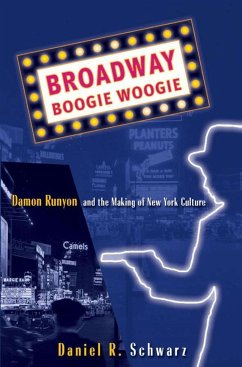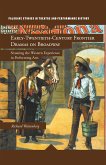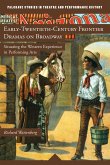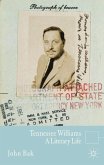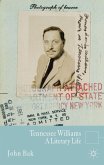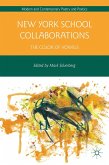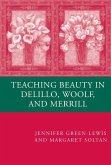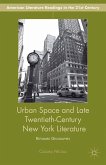While analyzing Damon Runyon's high spirited work in terms of historical contexts, popular culture, and of the changing function of the media, Schwarz argues that in his columns and stories Runyon was an indispensable figure in creating our public images of New York City culture, including our interest in the demi-monde and underworld that explains in part the success of The Godfather films and The Sopranos . In his lively and exuberant chapters that include a panoramic view of New York City between the World Wars - with a focus on its colourful nightlife - Schwarz examines virtually every facet of Runyon's career from sports writer, daily columnist, trial reporter, and Hollywood figure to the author of the still widely-read short stories that were the source of the Broadway hit Guys and Dolls . As part of his discussion of Runyon's art and the artistry of Runyon's fiction, Schwarz skilfully examines the special language of the Broadway stories known as 'Runyonese', and explains how 'Runyonese' has become an adjective for describing flamboyant behaviour.
Hinweis: Dieser Artikel kann nur an eine deutsche Lieferadresse ausgeliefert werden.
Hinweis: Dieser Artikel kann nur an eine deutsche Lieferadresse ausgeliefert werden.
'Runyon exerted infulence far beyond writing a story and had an enormous impact on popular culture in America. Recommended...' - Katherine E. Merrill, Library Journal
''Runyonese' evoke[s] a perhaps mythical Manhatten occupied by amusing, sometimes violent or greedy perps.' - James Boylan, Columbia Journalism Review
'If you love anything to do with the history of New York City, Dan Schwarz has written just the book for you. Broadway Boogie Woogie: Damon Runyon and the Making of New York City Culture is a fascinating look at the gritty nether world in which writer Damon Runyon lived and worked...Between the two world wars, Runyon wrote from an insider's view of the city's underbelly. The high-rollers, the glitzy nightlife, the underworld characters, the palookas he wrote about transfixed his readers much as the gory photogravure tabloid shots by crime photographer 'Weegee' (Arthur Fellig) who could find 'beauty' even at a murder scene.' - Monica Finch, Union College
'Schwarz's book shows how Runyon captured - and in some ways created - the sights and sounds of New York City in the first half of the twentieth century. [According to Schwarz], 'To read Runyon is to read New York City history between 1910 and 1946...His trial reporting had much to do with creating the spectator culture.' One of the best chapters in the book deals with that topic. Among the trials Runyon covered was the ordeal of Bruno Richard Hauptmann, who was convicted in the 1932 kidnapping and death of Charles A. Lindbergh, Jr., the 20-months son of Charles and Anne Lindbergh. Runyon, whose short story 'The Idyll of Sarah Brown', became the hit Broadway musical 'Guys and Dolls', could provide both [entertainment and information].'
'Schwarz revels in describing the impact and style of Runyon, who was one of the two most important, and hard-working, columnists in America from the 1920s until his death in 1946. The other was Walter Winchell...Runyon's impact was widespread...'
'Runyon was tailor-made for New York City, which he draped with memorable characters, such as Harry the Horse, Sky Masterson, Dave the Dude, and Apple Annie. Runyon was a good listener, Schwarz says. That allowed him to absorb the tone of the times. According to Schwarz, 'Runyon understood that...talk is performance...He told people what New York was about.' That meant, primarily, show business, crime, and politics.'
'The focus on Runyon is an apt vehicle for Schwarz's larger goal of writing a book about the culture of New York City.' - Frank Heron, The Syracuse Post-Standard
'Moving from one work to the next, Schwarz...summarizes and discusses the vast oeuvre of Damon Runyon's fiction. Emphasis is given to the recurring motifs of gambling, vaudeville, and street sensibilities. The roots of these subjects in Runyon's own life and the influence of his representation of New York City on later writers are important themes.' - Reference & Research Book News
'...thought-provoking examination of Runyon and his historical context.' - T. D. Beal, Choice
''Runyonese' evoke[s] a perhaps mythical Manhatten occupied by amusing, sometimes violent or greedy perps.' - James Boylan, Columbia Journalism Review
'If you love anything to do with the history of New York City, Dan Schwarz has written just the book for you. Broadway Boogie Woogie: Damon Runyon and the Making of New York City Culture is a fascinating look at the gritty nether world in which writer Damon Runyon lived and worked...Between the two world wars, Runyon wrote from an insider's view of the city's underbelly. The high-rollers, the glitzy nightlife, the underworld characters, the palookas he wrote about transfixed his readers much as the gory photogravure tabloid shots by crime photographer 'Weegee' (Arthur Fellig) who could find 'beauty' even at a murder scene.' - Monica Finch, Union College
'Schwarz's book shows how Runyon captured - and in some ways created - the sights and sounds of New York City in the first half of the twentieth century. [According to Schwarz], 'To read Runyon is to read New York City history between 1910 and 1946...His trial reporting had much to do with creating the spectator culture.' One of the best chapters in the book deals with that topic. Among the trials Runyon covered was the ordeal of Bruno Richard Hauptmann, who was convicted in the 1932 kidnapping and death of Charles A. Lindbergh, Jr., the 20-months son of Charles and Anne Lindbergh. Runyon, whose short story 'The Idyll of Sarah Brown', became the hit Broadway musical 'Guys and Dolls', could provide both [entertainment and information].'
'Schwarz revels in describing the impact and style of Runyon, who was one of the two most important, and hard-working, columnists in America from the 1920s until his death in 1946. The other was Walter Winchell...Runyon's impact was widespread...'
'Runyon was tailor-made for New York City, which he draped with memorable characters, such as Harry the Horse, Sky Masterson, Dave the Dude, and Apple Annie. Runyon was a good listener, Schwarz says. That allowed him to absorb the tone of the times. According to Schwarz, 'Runyon understood that...talk is performance...He told people what New York was about.' That meant, primarily, show business, crime, and politics.'
'The focus on Runyon is an apt vehicle for Schwarz's larger goal of writing a book about the culture of New York City.' - Frank Heron, The Syracuse Post-Standard
'Moving from one work to the next, Schwarz...summarizes and discusses the vast oeuvre of Damon Runyon's fiction. Emphasis is given to the recurring motifs of gambling, vaudeville, and street sensibilities. The roots of these subjects in Runyon's own life and the influence of his representation of New York City on later writers are important themes.' - Reference & Research Book News
'...thought-provoking examination of Runyon and his historical context.' - T. D. Beal, Choice

